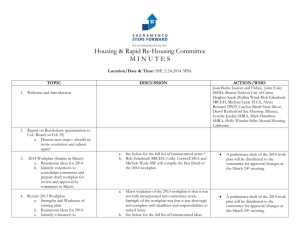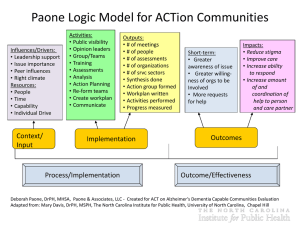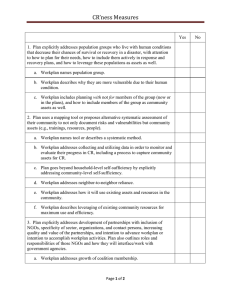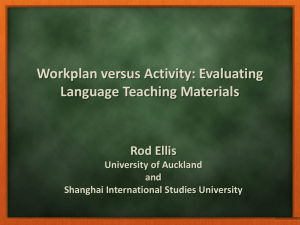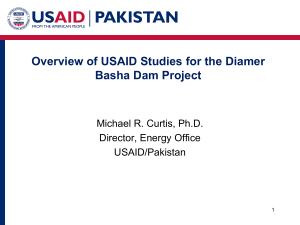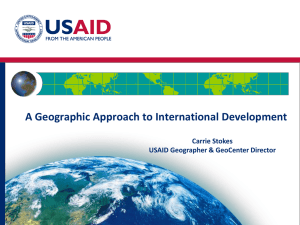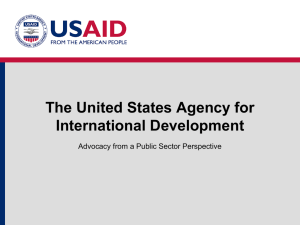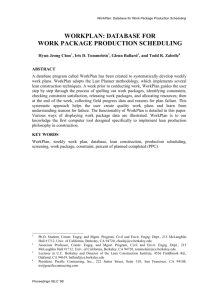Workplan Format - Legume Innovation Lab
advertisement
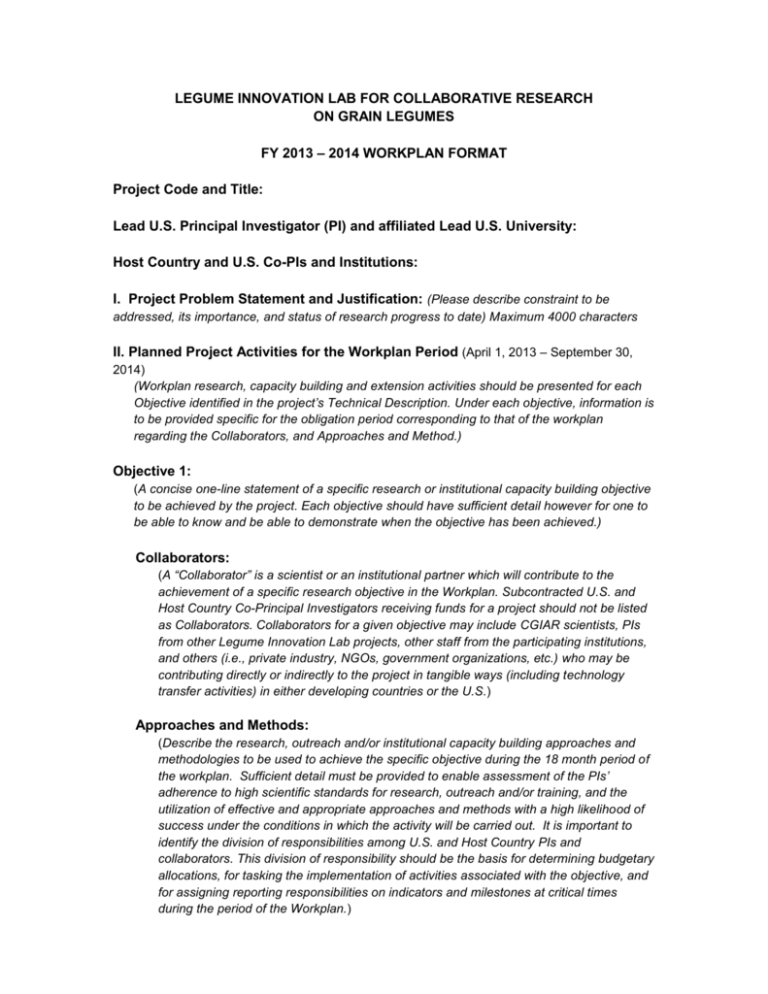
LEGUME INNOVATION LAB FOR COLLABORATIVE RESEARCH ON GRAIN LEGUMES FY 2013 – 2014 WORKPLAN FORMAT Project Code and Title: Lead U.S. Principal Investigator (PI) and affiliated Lead U.S. University: Host Country and U.S. Co-PIs and Institutions: I. Project Problem Statement and Justification: (Please describe constraint to be addressed, its importance, and status of research progress to date) Maximum 4000 characters II. Planned Project Activities for the Workplan Period (April 1, 2013 – September 30, 2014) (Workplan research, capacity building and extension activities should be presented for each Objective identified in the project’s Technical Description. Under each objective, information is to be provided specific for the obligation period corresponding to that of the workplan regarding the Collaborators, and Approaches and Method.) Objective 1: (A concise one-line statement of a specific research or institutional capacity building objective to be achieved by the project. Each objective should have sufficient detail however for one to be able to know and be able to demonstrate when the objective has been achieved.) Collaborators: (A “Collaborator” is a scientist or an institutional partner which will contribute to the achievement of a specific research objective in the Workplan. Subcontracted U.S. and Host Country Co-Principal Investigators receiving funds for a project should not be listed as Collaborators. Collaborators for a given objective may include CGIAR scientists, PIs from other Legume Innovation Lab projects, other staff from the participating institutions, and others (i.e., private industry, NGOs, government organizations, etc.) who may be contributing directly or indirectly to the project in tangible ways (including technology transfer activities) in either developing countries or the U.S.) Approaches and Methods: (Describe the research, outreach and/or institutional capacity building approaches and methodologies to be used to achieve the specific objective during the 18 month period of the workplan. Sufficient detail must be provided to enable assessment of the PIs’ adherence to high scientific standards for research, outreach and/or training, and the utilization of effective and appropriate approaches and methods with a high likelihood of success under the conditions in which the activity will be carried out. It is important to identify the division of responsibilities among U.S. and Host Country PIs and collaborators. This division of responsibility should be the basis for determining budgetary allocations, for tasking the implementation of activities associated with the objective, and for assigning reporting responsibilities on indicators and milestones at critical times during the period of the Workplan.) Objective 2: Collaborators: Approaches and Methods: Objective 3…: Collaborators: Approaches and Methods: Objective __: (The final objective should be “to increase the capacity, effectiveness and sustainability of agriculture research institutions which serve the bean and cowpea sectors in the target FTF countries.” The narrative under the Approach to achieving this institutional capacity building objective must be consistent with the “Strategy for Institutional Capacity Building” presented in the Technical Project Description. Specific plans and detailed information on degree training, short-term training, and investments in equipment (>$5,000) planned during the workplan period must be provided by completing the separate section on "Workplan for Training/Capacity Building." However, under this objective, please list the capacity building activities planned in the workplan period by providing a list of degree trainees (their names, citizenship, degree program and training location) and short-term training activities (a brief description and information on when/where this activity will take place). Also describe your plans (if any) for investment in equipment to improve the research or outreach capacity of specific partner host country institutions.). III. Contribution of Project to USAID Feed the Future Performance Indicators: (Complete the “Performance Indicators – Targets” form for the project for FY 2013, 2014 and 2015. It is important that these targets reflect a thoughtful estimation of planned and projected outputs and outcomes from the activities of each participating institution in this project in the FTF countries. For your assistance, the MO will be sending each Lead PI a “Handbook on Performance Indicators for the Legume Innovation Lab” which provides you with definitions and guidance onr reporting of Performance Indicators. It is imperative that Performance Indicator “Actual” data, reported at the end of each fiscal year, be of integrity as USAID will be requiring greater accountability by the Legume Innovation Lab. Lead PIs should therefore take measures to systematically collect and verify the accuracy of all Performance Indicator obtained from partners during the course of each fiscal year.) IV. Outputs: (Identify specific outputs to result from this project during the 18 month period of this workplan. Please be reminded that outputs are a measure of project productivity and the basis for assessment of research performance by the Technical Management Advisory Committee at the end of each fiscal year. It is therefore critical that thought be given to clearly defining these outputs, since the project team will be held accountable for achieving them.) V. Engagement of USAID Field Mission(s) (Identify specific activities to be carried out during the 18 month workplan period to engage USAID country or regional missions so as to inform them of Legume Innovation Lab activities within the respective country and their contributions to FTF objectives and mission development strategies. There is also value in introducing HC partners and collaborators to USAID Mission economic growth and FTF staff. Please be informed that Missions have the opportunity to contract the services of the Legume Innovation Lab and its partners through an Associate Award to the Leader award.) VI. Partnering and Networking Activities: (Identify planned partnering and networking activities to ensure that outputs are handedoff to the appropriate public and private sector institutions for follow-up adaptive research and field validation, in addition to technology transfer, in FTF countries and regions. These partners and activities should be consistent with the Impact Pathway Plan for the project. The follow up activities are not necessarily expected to be supported financially by the Legume Innovation Lab project, however, USAID desires that PIs be accountable for making such arrangements so that research outputs are disseminated on a wide scale for quantifiable developmental impact.) VII. Leveraging of CRSP Resources: (Identify existing or future opportunities and plans to pursue and leverage additional resources in support of Legume Innovation Lab research, training and outreach activities. Describe briefly how leveraged funding (i.e., USDA-ARS, NIFA, NSF, USAID, McKnight, Gates, CGIAR, etc.) would be complementary to and coordinated with planned activities described in this Workplan of the Legume Innovation Lab project.) VIII. Timeline for Achievement of Milestones of Technical Progress: (Complete the "Milestones for Technical Progress” form for the workplan period. These milestones of progress should be viewed as specific “benchmarks” toward achievement of research, outreach and institutional capacity building objectives by the respective participating institutions, plus be considered as specific “deliverables” for incremental payments under Fixed Term Contracts with sub-subcontracted institutions in the project. Success in achieving milestones will also be reported at the end of each fiscal year and be a criterion for evaluation of project performance by the TMAC and USAID. It is therefore important that the milestones be clearly identified (in terms of its size/scale/scope and target location), quantitative (to the extent possible), and logistically feasible, with the responsible institution(s) for completing them specified.) Training/Capacity Building Workplan for FY 2013 – 2014 (use format below) Degree Training: First and Other Given Names Last Name Citizenship Gender Training Institution Supervising CRSP PI Degree Program for training Program Areas or Discipline If enrolled at a US university, will Trainee be a “Participant Trainee” as defined by USAID? Host Country Institution to Benefit from Training Thesis Title/Research Area Start Date Projected Completion Date Training status (Active, completed, pending, discontinued or delayed) Type of CRSP Support (full, partial or indirect) g for training activity Short-term Training: Type of training Description of training activity Location Duration When will it occur? Participants/Beneficiaries of Training Activity Anticipated numbers of Beneficiaries (male and female) PI/Collaborator responsible for this training activity List other funding sources that will be sought (if any) Training justification Equipment (costing >$5,000): Specific Type of Equipment to be purchased Justification for equipment to achieve workplan objectives Institution to benefit from equipment Institution to purchase equipment Amount budgeted for equipment item
